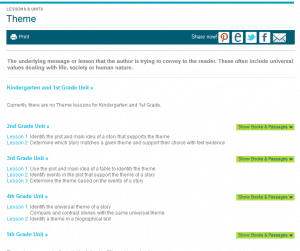Common Core Reading Lessons: Theme
 The underlying message or lesson that the author is trying to convey to the reader. These often include universal values dealing with life, society or human nature.
The underlying message or lesson that the author is trying to convey to the reader. These often include universal values dealing with life, society or human nature.
Theme Lessons - Covers second through sixth grade. Examples: Identify the plot and main idea of a story that supports the theme. Identify events in the plot that support the theme of a story. Compare and contrast stories with the same universal theme.
Integration of Knowledge and Ideas
CCSS.ELA-Literacy.RL.2.7 Use information gained from the illustrations and words in a print or digital text to demonstrate understanding of its characters, setting, or plot.
Comprehension and Collaboration
CCSS.ELA-Literacy.SL.3.2 Determine the main ideas and supporting details of a text read aloud or information presented in diverse media and formats, including visually, quantitatively, and orally.
Key Ideas and Details
CCSS.ELA-Literacy.RL.3.1 Ask and answer questions to demonstrate understanding of a text, referring explicitly to the text as the basis for the answers.
CCSS.ELA-Literacy.RL.3.2 Recount stories, including fables, folktales, and myths from diverse cultures; determine the central message, lesson, or moral and explain how it is conveyed through key details in the text.
Range of Reading and Level of Text Complexity
CCSS.ELA-Literacy.RL.3.10 By the end of the year, read and comprehend literature, including stories, dramas, and poetry, at the high end of the grades 2-3 text complexity band independently and proficiently.
Integration of Knowledge and Ideas
CCSS.ELA-Literacy.RI.3.7 Use information gained from illustrations (e.g., maps, photographs) and the words in a text to demonstrate understanding of the text (e.g., where, when, why, and how key events occur).
Fluency
CCSS.ELA-Literacy.RF.3.4 Read with sufficient accuracy and fluency to support comprehension.
CCSS.ELA-Literacy.RF.3.4a Read on-level text with purpose and understanding.
CCSS.ELA-Literacy.RF.3.4c Use context to confirm or self-correct word recognition and understanding, rereading as necessary.
Comprehension and Collaboration
CCSS.ELA-Literacy.SL.3.2 Determine the main ideas and supporting details of a text read aloud or information presented in diverse media and formats, including visually, quantitatively, and orally.
Craft and Structure
CCSS.ELA-Literacy.RL.4.6 Compare and contrast the point of view from which different stories are narrated, including the difference between first- and third-person narrations.
Integration of Knowledge and Ideas
CCSS.ELA-Literacy.RL.4.9 Compare and contrast the treatment of similar themes and topics (e.g., opposition of good and evil) and patterns of events (e.g., the quest) in stories, myths, and traditional literature from different cultures.
Key Ideas and Details
CCSS.ELA-Literacy.RL.4.2 Determine a theme of a story, drama, or poem from details in the text; summarize the text.
Key Ideas and Details
CCSS.ELA-Literacy.RI.4.1 Refer to details and examples in a text when explaining what the text says explicitly and when drawing inferences from the text.
CCSS.ELA-Literacy.RI.4.2 Determine the main idea of a text and explain how it is supported by key details; summarize the text.
CCSS.ELA-Literacy.RI.4.3 Explain events, procedures, ideas, or concepts in a historical, scientific, or technical text, including what happened and why, based on specific information in the text.
Integration of Knowledge and Ideas
CCSS.ELA-Literacy.RI.4.8 Explain how an author uses reasons and evidence to support particular points in a text.